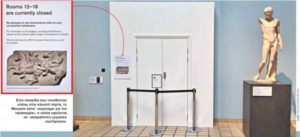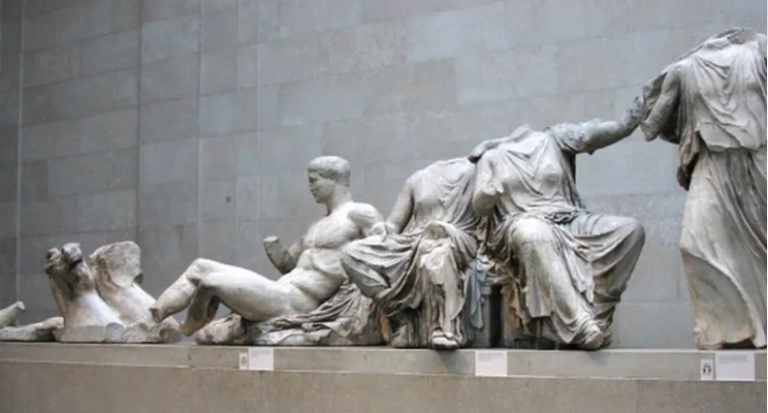The rooms that houses the invaluable ancient Greek treasures created by Pheidias are still not accessible to the public, unlike the other rooms of the British Museum, which have been open since last May, when the last lockdown in Britain ended.
A spokesman for the Museum who spoke to the newspaper “Ta Nea” was not able to give specific answers, generally talking about a “repair and maintenance program” that take place in its rooms.
As for when they will reopen? At some point “later in the fall” is the answer… In total, six rooms with ancient Greek exhibits remain closed: rooms 15, 16, 17 and 18 (where the Parthenon Marbles are exhibited), which do not work due to “repairs”, and rooms 19 and 20, which do not receive visitors due to “compliance with the measures for the coronavirus”. Surprisingly enough, though, the employees of the Museum, when asked, give different versions both for the reason that keeps the “Greek” rooms closed, from December 2020, and regarding the time they will reopen.

The newspaper “Ta Nea” asked four members of the Museum staff who have the authority to answer questions from the public, and received four different answers.
“We do not know exactly when they will open. Maybe in a month. Do you live in London? If so, come back soon or call us “, the first employee told us.
– Why are the rooms closed? Because of the leak in the roof?
– “Yes, and also for general maintenance. We hope that the rooms will be open by the end of the year”, said the second employee of the Museum we asked, admitting that what keeps them closed is a water leak. “You know, the building is old”, she said trying to justify the situation.
A third employee made the same admission. “We are working to tackle the leak”, he said, adding that “our expectation is that the halls will reopen before the end of 2021”.
However, a fourth employee…disagreed with the previous ones: “Renovation work is underway. Leaks are rumors and are drawn out of proportion. I think the room will open soon”, he said.
The representatives of the campaign for the repatriation of the Marbles are upset, expressing their concern even for the state of the Sculptures.
On August 15, the International Partnership for the Reunification of the Parthenon (IARPS), representing 21 national committees from around the world, wrote about the issue to Museum President Sir Richard Lambert and to its Director Dr. Hartwich Fischer.
In the letter, the Union expresses its “deep concern” about the fact that the room remains closed, emphasizing that “the possible problem of humidity creates a dangerous situation for the Sculptures”. At the same time, it calls on the Museum to “reconsider its position on the ongoing division of the Sculptures”, noting its “moral obligation” to reunite all the surviving Sculptures in the Acropolis Museum.
“It is unfortunate that Room 18 has been closed since last December until recently,” IARPS President Dr Chris Titgat told NEA, noting that “the poor air conditioning conditions in the room are a cause for concern. I hope”, he added, “that we do not have to wait another 22 years to admire the Parthenon Sculptures in London again, as happened in 1940, when the Duvin Gallery was hit by a bomb and remained closed until 1962! At that time, of course, the Sculptures were kept in a safe place and remained intact”.
Albanian prosecutors’ absurd conclusion: Konstantinos Katsifas committed suicide!
Almost two months later, the Museum did not respond to the letter, which Dr. Titgat described as something “sad”. “It simply came to our notice then. Is this how they are having a dialogue on such an urgent issue? It’s time for the British Museum and Britain to move into the 21st century. I would be happy if Room 18 were closed permanently, and not temporarily as it is now, because that would mean that the magnificent Sculptures snatched by the looting Lord Elgin would be reunited at the Acropolis Museum”, said the chair of the British Committee for the Reunification of the Parthenon Marbles (BCRPM) Janet Suzman.
“No one can say for sure what kind of works are made in the Greek rooms of the British Museum and for how long”, added the internationally renowned Shakespearean actress, stressing that “the poor exhibition conditions of the Sculptures have been pointed out by BCRPM in many cases in winter: heaters, open emergency exits in summer, water leaking from the roof when it rains. We call on the British Museum to allow the reunification of the Sculptures in the emblematic Acropolis Museum”.
The “Greek” rooms were closed to the public on December 16, 2020, when the building was locked due to the lockdown imposed by the British government. The Museum reopened five months later, on May 17, 2021. However, the rooms of Ancient Greece remained closed, with those in charge constantly postponing the date of their reopening.
The heavy rain on July 25 in London caused, once again, water leakage in the Marbles’ room, at a distance of a few centimeters from the exhibits. Proponents of their return express concern that moisture could damage the ancient works of art. The website of the British Museum states that the “Greek” rooms are closed until further notice, due to “regular maintenance work”.
Visitors to the Museum, walking to Room 18 – known as the Duvin Gallery -which houses the Sculptures- are forced to stop in Room 23. There, a plywood door, recently installed as part of a temporary structure, blocks the entrance to the other Greek exhibitions.
The problem of water leakage in Room 18 was first highlighted in December 2018. Since then, it remains unresolved, with many commentators talking about an unacceptable and embarrassing situation for a museum of British fame. Ten days ago, UNESCO highlighted the poor conditions of the Sculpture Exhibition, expressing “its concern that the Duvin Gallery is not open to the public due to necessary repairs” and adding that it “looks forward to reopening in due course”. Almost every time it rains, water accumulates on the roof, which sometimes drips into the Sculptures’ room. Usually, the situation is treated with…buckets placed next to the Marbles and with pieces of cloth spread on the floor! At the same time, mold marks have been visible on the roof for at least 20 years. This time, however, it seems that the problem is more serious and keeps the room closed for almost a year. In his exclusive interview with “Ta Nea”, in January 2019, the director of the Museum, Dr. Hartwich Fischer, had claimed that this was “a small leak” that was “corrected immediately”. The reality, however, proves him wrong.
“It is shocking that a world-class museum is forced to close its rooms due to water or moisture leaks. Almost three years later, it appears that this ‘small leak’ has not yet been fixed. On the contrary, it has led to the closure of the room for a number of months”, Marlene Godwin, the British Commission’s director of international relations, stated. She added: “The fact that we are not told when it will open, at least shows a lack of professionalism”. The last time the problem arose was in August. “The conditions for exhibiting the sculptures at the British Museum are from offensive to dangerous”, said Culture Minister Lina Mendoni. However, a source in the Museum claimed that “the problem with the leaks has been fixed”.
Ask me anything
Explore related questions





